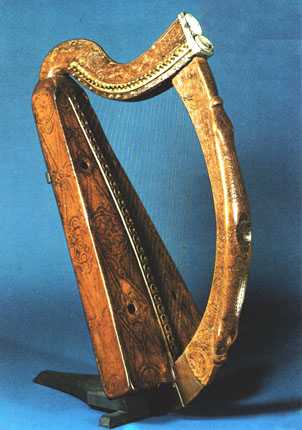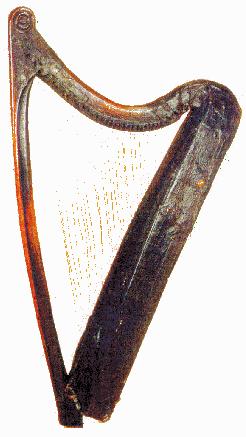
Turlough O'Carolan
1670-1738

| Harp
History |
The harp came
to Europe from Egypt thousands of years ago. It became a cornerstone
in Irish history and nationalism. The Trinity College Harp (pictured
at right) is what appears on Ireland's national symbol. The harp can
be found on coins, flags, and manufactured goods, such as beer. As early as the 10th century, harpists would travel Ireland playing for patrons of all types, including King Griffith of Wales. This tradition continued until the early 1700's when England gained control of Ireland. Because the harp respresented Irish nationalism, the harp was banned, and many harps were burned and harpers executed. It was not until 1792 that the harp was revived at the Belfast Festival. The harp has enjoyed centuries of success since its revival. The Chieftans' harper is well known for his talent. Other popular harpists are Alison Kinnaird and Patrick Ball. |
 Trinity College Harp |
| About
Turlough O'Carolan |
Turlough O'Carolan
was born in 1670 to a poor family. He was educated by the MacDermott
Roe family for whom his parents worked. At 18, O'Carolan
was blinded by smallpox and Mrs. MacDermott Roe gave him a harp. He
started traveling Ireland composing and performing. He continued this
for most of his life. He had seven children with his wife, Mary Maquire,
before dying in 1738. O'Carolan is known for his compositions. He combined different styles of traditional Irish music, unlike most composers. To read more about Turlough O'Carolan and listen to his music, go to http://www.contemplator.com/carolan/ |
 Turlough O'Carolan's Harp |
| Can
I learn how to play? |
There are harp
schools and festivals where you can learn how to play. Check out http://www.angelfire.com/va/traditionalmusic/resources.html
and http://www.harp.net for information
about where you can go to learn. |
|
| Other Interesting Sites: |
The following site has links to
dozens of harp related webpages: http://www.tns.lcs.mit.edu/harp/ |

